Autumn 2017: Health Policy, Power, and Politics Assignment
VerifiedAdded on 2023/01/09
|9
|2285
|94
Homework Assignment
AI Summary
This assignment delves into the realm of health policy, power dynamics, and political influences in healthcare. It begins by examining the policy cycle as a tool for developing new policies, highlighting its structured approach and stakeholder involvement. The assignment then explores key sociological issues, such as nutritional diseases, lack of education, and unemployment, and their impact on health outcomes. It defines the concept of power in policy development, differentiating between visible, hidden, and invisible forms of power and their significance in driving policy changes. The assignment further analyzes policy considerations for a national obesity health campaign, emphasizing the need for a broad audience, constructive legislation, and sensitive communication strategies. Finally, it outlines factors to be included in creating a new policy to develop a smoke-free environment within a university setting, considering student reactions, approaches to tobacco control, and the influence of post-secondary education.
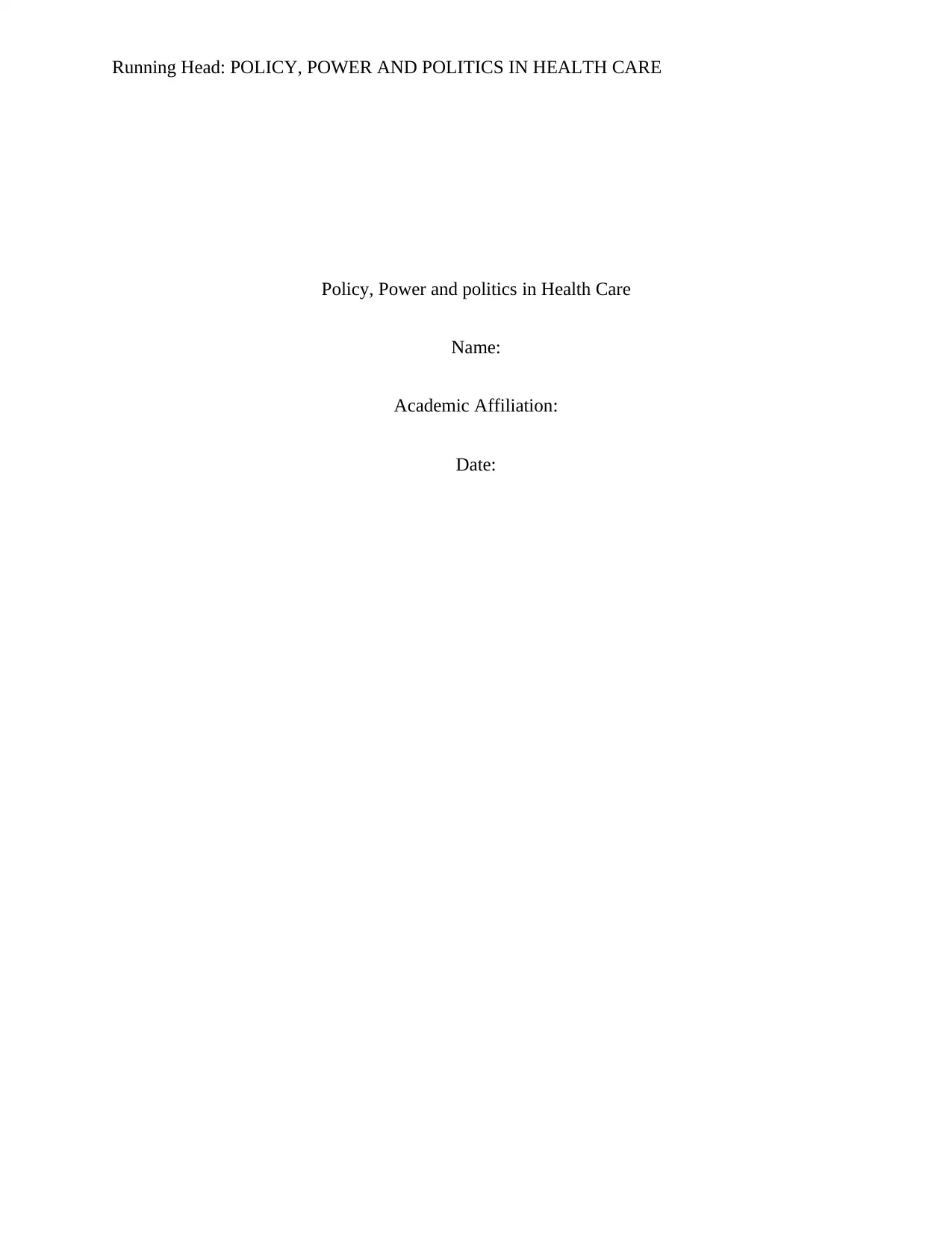
Running Head: POLICY, POWER AND POLITICS IN HEALTH CARE
Policy, Power and politics in Health Care
Name:
Academic Affiliation:
Date:
Policy, Power and politics in Health Care
Name:
Academic Affiliation:
Date:
Paraphrase This Document
Need a fresh take? Get an instant paraphrase of this document with our AI Paraphraser
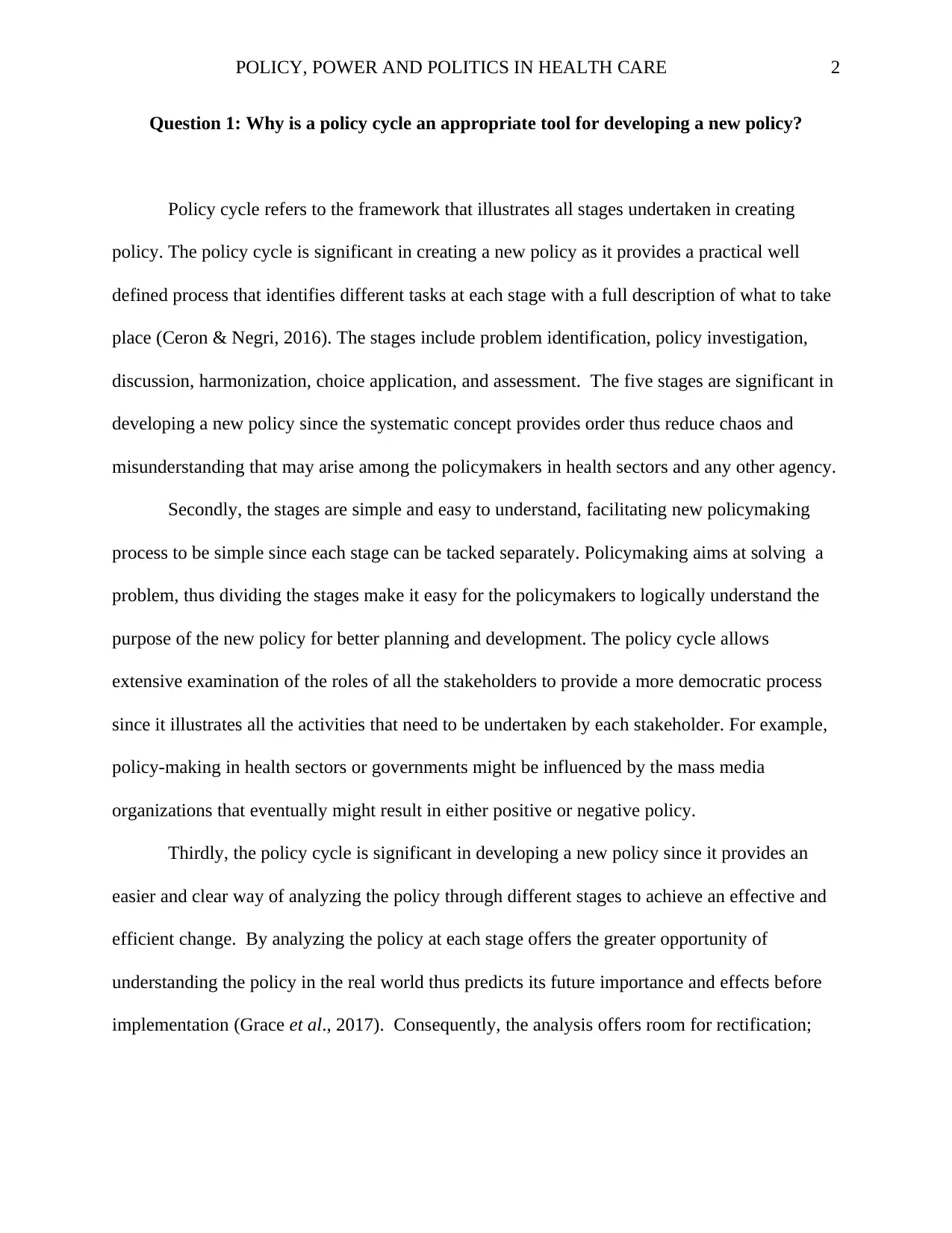
POLICY, POWER AND POLITICS IN HEALTH CARE 2
Question 1: Why is a policy cycle an appropriate tool for developing a new policy?
Policy cycle refers to the framework that illustrates all stages undertaken in creating
policy. The policy cycle is significant in creating a new policy as it provides a practical well
defined process that identifies different tasks at each stage with a full description of what to take
place (Ceron & Negri, 2016). The stages include problem identification, policy investigation,
discussion, harmonization, choice application, and assessment. The five stages are significant in
developing a new policy since the systematic concept provides order thus reduce chaos and
misunderstanding that may arise among the policymakers in health sectors and any other agency.
Secondly, the stages are simple and easy to understand, facilitating new policymaking
process to be simple since each stage can be tacked separately. Policymaking aims at solving a
problem, thus dividing the stages make it easy for the policymakers to logically understand the
purpose of the new policy for better planning and development. The policy cycle allows
extensive examination of the roles of all the stakeholders to provide a more democratic process
since it illustrates all the activities that need to be undertaken by each stakeholder. For example,
policy-making in health sectors or governments might be influenced by the mass media
organizations that eventually might result in either positive or negative policy.
Thirdly, the policy cycle is significant in developing a new policy since it provides an
easier and clear way of analyzing the policy through different stages to achieve an effective and
efficient change. By analyzing the policy at each stage offers the greater opportunity of
understanding the policy in the real world thus predicts its future importance and effects before
implementation (Grace et al., 2017). Consequently, the analysis offers room for rectification;
Question 1: Why is a policy cycle an appropriate tool for developing a new policy?
Policy cycle refers to the framework that illustrates all stages undertaken in creating
policy. The policy cycle is significant in creating a new policy as it provides a practical well
defined process that identifies different tasks at each stage with a full description of what to take
place (Ceron & Negri, 2016). The stages include problem identification, policy investigation,
discussion, harmonization, choice application, and assessment. The five stages are significant in
developing a new policy since the systematic concept provides order thus reduce chaos and
misunderstanding that may arise among the policymakers in health sectors and any other agency.
Secondly, the stages are simple and easy to understand, facilitating new policymaking
process to be simple since each stage can be tacked separately. Policymaking aims at solving a
problem, thus dividing the stages make it easy for the policymakers to logically understand the
purpose of the new policy for better planning and development. The policy cycle allows
extensive examination of the roles of all the stakeholders to provide a more democratic process
since it illustrates all the activities that need to be undertaken by each stakeholder. For example,
policy-making in health sectors or governments might be influenced by the mass media
organizations that eventually might result in either positive or negative policy.
Thirdly, the policy cycle is significant in developing a new policy since it provides an
easier and clear way of analyzing the policy through different stages to achieve an effective and
efficient change. By analyzing the policy at each stage offers the greater opportunity of
understanding the policy in the real world thus predicts its future importance and effects before
implementation (Grace et al., 2017). Consequently, the analysis offers room for rectification;
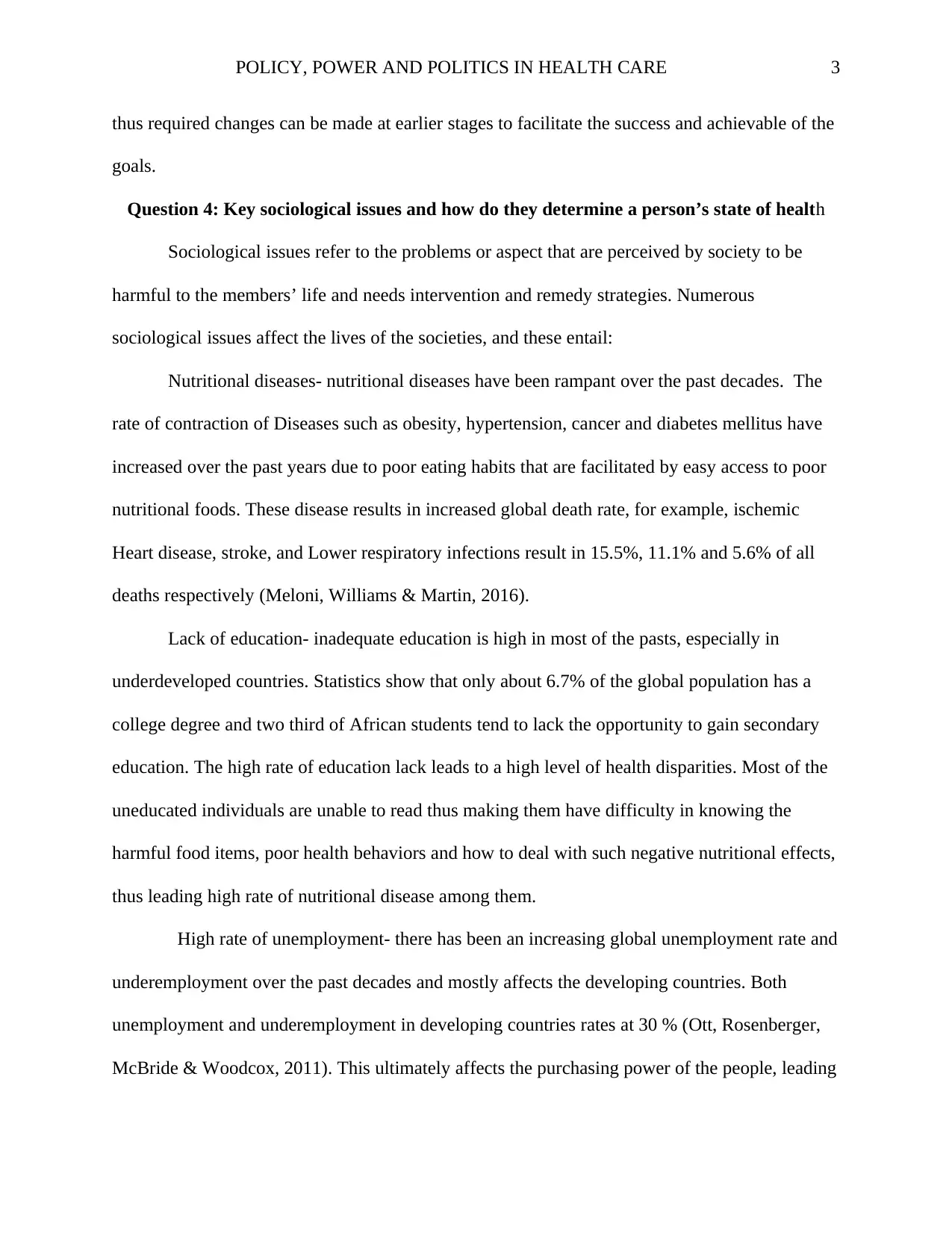
POLICY, POWER AND POLITICS IN HEALTH CARE 3
thus required changes can be made at earlier stages to facilitate the success and achievable of the
goals.
Question 4: Key sociological issues and how do they determine a person’s state of health
Sociological issues refer to the problems or aspect that are perceived by society to be
harmful to the members’ life and needs intervention and remedy strategies. Numerous
sociological issues affect the lives of the societies, and these entail:
Nutritional diseases- nutritional diseases have been rampant over the past decades. The
rate of contraction of Diseases such as obesity, hypertension, cancer and diabetes mellitus have
increased over the past years due to poor eating habits that are facilitated by easy access to poor
nutritional foods. These disease results in increased global death rate, for example, ischemic
Heart disease, stroke, and Lower respiratory infections result in 15.5%, 11.1% and 5.6% of all
deaths respectively (Meloni, Williams & Martin, 2016).
Lack of education- inadequate education is high in most of the pasts, especially in
underdeveloped countries. Statistics show that only about 6.7% of the global population has a
college degree and two third of African students tend to lack the opportunity to gain secondary
education. The high rate of education lack leads to a high level of health disparities. Most of the
uneducated individuals are unable to read thus making them have difficulty in knowing the
harmful food items, poor health behaviors and how to deal with such negative nutritional effects,
thus leading high rate of nutritional disease among them.
High rate of unemployment- there has been an increasing global unemployment rate and
underemployment over the past decades and mostly affects the developing countries. Both
unemployment and underemployment in developing countries rates at 30 % (Ott, Rosenberger,
McBride & Woodcox, 2011). This ultimately affects the purchasing power of the people, leading
thus required changes can be made at earlier stages to facilitate the success and achievable of the
goals.
Question 4: Key sociological issues and how do they determine a person’s state of health
Sociological issues refer to the problems or aspect that are perceived by society to be
harmful to the members’ life and needs intervention and remedy strategies. Numerous
sociological issues affect the lives of the societies, and these entail:
Nutritional diseases- nutritional diseases have been rampant over the past decades. The
rate of contraction of Diseases such as obesity, hypertension, cancer and diabetes mellitus have
increased over the past years due to poor eating habits that are facilitated by easy access to poor
nutritional foods. These disease results in increased global death rate, for example, ischemic
Heart disease, stroke, and Lower respiratory infections result in 15.5%, 11.1% and 5.6% of all
deaths respectively (Meloni, Williams & Martin, 2016).
Lack of education- inadequate education is high in most of the pasts, especially in
underdeveloped countries. Statistics show that only about 6.7% of the global population has a
college degree and two third of African students tend to lack the opportunity to gain secondary
education. The high rate of education lack leads to a high level of health disparities. Most of the
uneducated individuals are unable to read thus making them have difficulty in knowing the
harmful food items, poor health behaviors and how to deal with such negative nutritional effects,
thus leading high rate of nutritional disease among them.
High rate of unemployment- there has been an increasing global unemployment rate and
underemployment over the past decades and mostly affects the developing countries. Both
unemployment and underemployment in developing countries rates at 30 % (Ott, Rosenberger,
McBride & Woodcox, 2011). This ultimately affects the purchasing power of the people, leading
⊘ This is a preview!⊘
Do you want full access?
Subscribe today to unlock all pages.

Trusted by 1+ million students worldwide
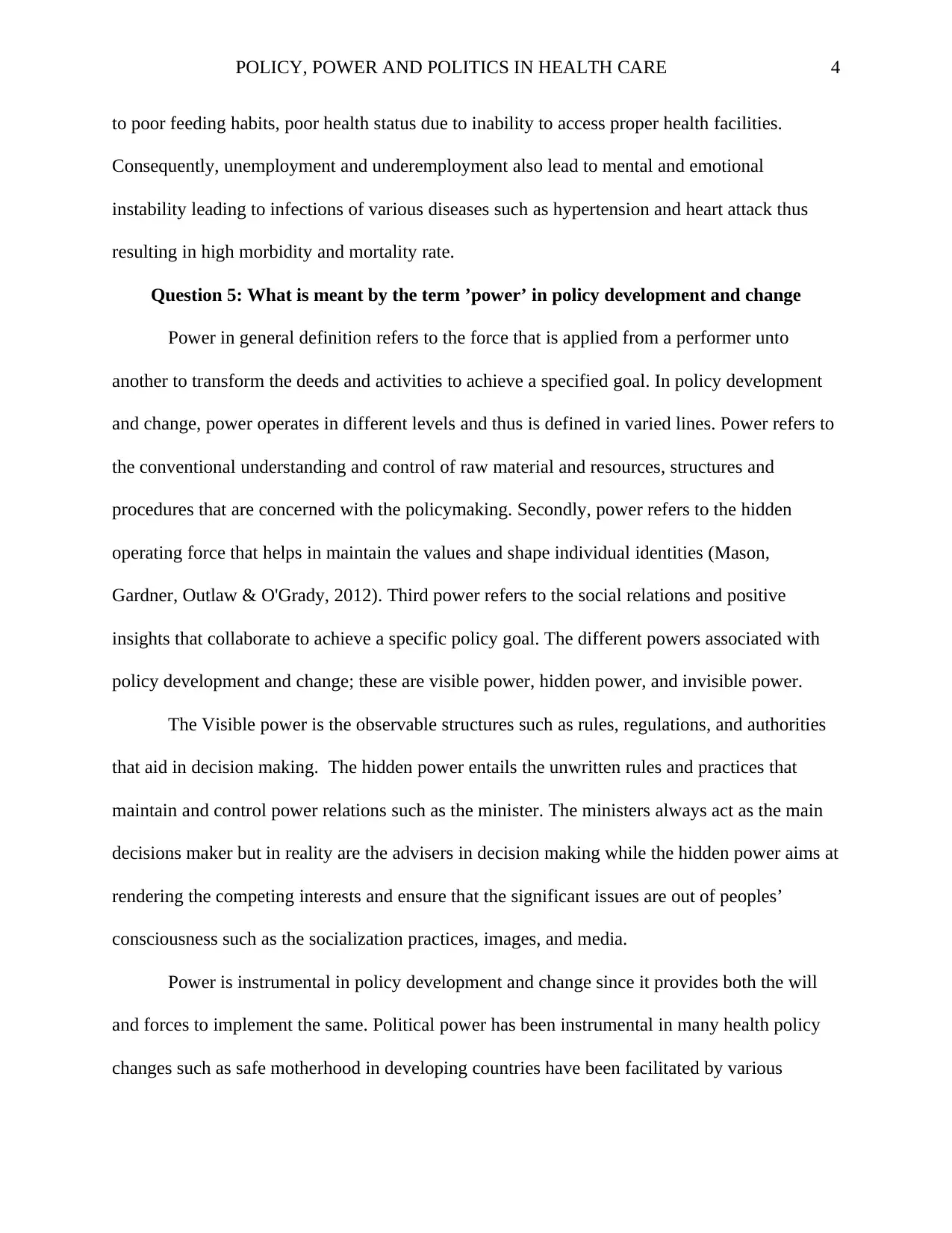
POLICY, POWER AND POLITICS IN HEALTH CARE 4
to poor feeding habits, poor health status due to inability to access proper health facilities.
Consequently, unemployment and underemployment also lead to mental and emotional
instability leading to infections of various diseases such as hypertension and heart attack thus
resulting in high morbidity and mortality rate.
Question 5: What is meant by the term ’power’ in policy development and change
Power in general definition refers to the force that is applied from a performer unto
another to transform the deeds and activities to achieve a specified goal. In policy development
and change, power operates in different levels and thus is defined in varied lines. Power refers to
the conventional understanding and control of raw material and resources, structures and
procedures that are concerned with the policymaking. Secondly, power refers to the hidden
operating force that helps in maintain the values and shape individual identities (Mason,
Gardner, Outlaw & O'Grady, 2012). Third power refers to the social relations and positive
insights that collaborate to achieve a specific policy goal. The different powers associated with
policy development and change; these are visible power, hidden power, and invisible power.
The Visible power is the observable structures such as rules, regulations, and authorities
that aid in decision making. The hidden power entails the unwritten rules and practices that
maintain and control power relations such as the minister. The ministers always act as the main
decisions maker but in reality are the advisers in decision making while the hidden power aims at
rendering the competing interests and ensure that the significant issues are out of peoples’
consciousness such as the socialization practices, images, and media.
Power is instrumental in policy development and change since it provides both the will
and forces to implement the same. Political power has been instrumental in many health policy
changes such as safe motherhood in developing countries have been facilitated by various
to poor feeding habits, poor health status due to inability to access proper health facilities.
Consequently, unemployment and underemployment also lead to mental and emotional
instability leading to infections of various diseases such as hypertension and heart attack thus
resulting in high morbidity and mortality rate.
Question 5: What is meant by the term ’power’ in policy development and change
Power in general definition refers to the force that is applied from a performer unto
another to transform the deeds and activities to achieve a specified goal. In policy development
and change, power operates in different levels and thus is defined in varied lines. Power refers to
the conventional understanding and control of raw material and resources, structures and
procedures that are concerned with the policymaking. Secondly, power refers to the hidden
operating force that helps in maintain the values and shape individual identities (Mason,
Gardner, Outlaw & O'Grady, 2012). Third power refers to the social relations and positive
insights that collaborate to achieve a specific policy goal. The different powers associated with
policy development and change; these are visible power, hidden power, and invisible power.
The Visible power is the observable structures such as rules, regulations, and authorities
that aid in decision making. The hidden power entails the unwritten rules and practices that
maintain and control power relations such as the minister. The ministers always act as the main
decisions maker but in reality are the advisers in decision making while the hidden power aims at
rendering the competing interests and ensure that the significant issues are out of peoples’
consciousness such as the socialization practices, images, and media.
Power is instrumental in policy development and change since it provides both the will
and forces to implement the same. Political power has been instrumental in many health policy
changes such as safe motherhood in developing countries have been facilitated by various
Paraphrase This Document
Need a fresh take? Get an instant paraphrase of this document with our AI Paraphraser
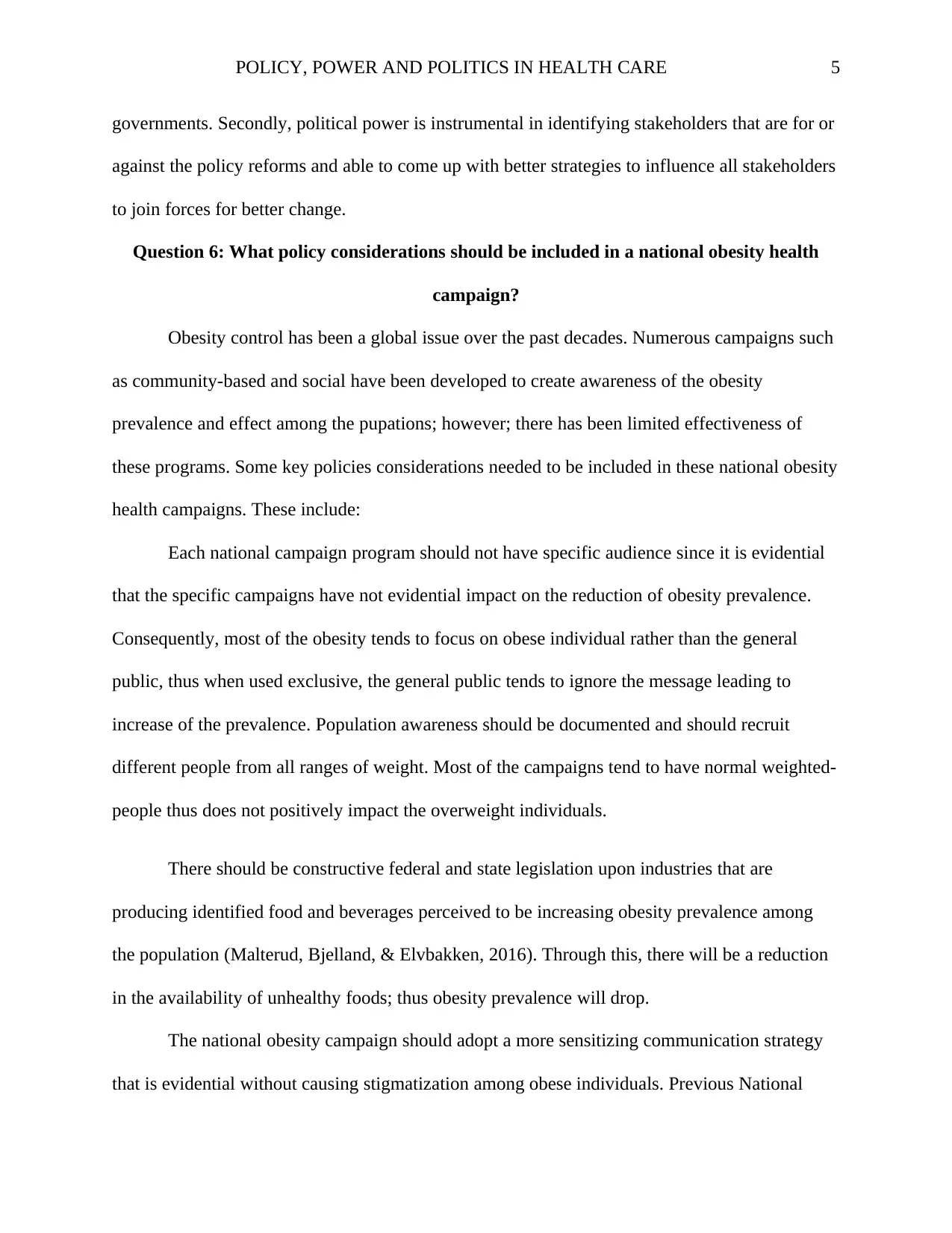
POLICY, POWER AND POLITICS IN HEALTH CARE 5
governments. Secondly, political power is instrumental in identifying stakeholders that are for or
against the policy reforms and able to come up with better strategies to influence all stakeholders
to join forces for better change.
Question 6: What policy considerations should be included in a national obesity health
campaign?
Obesity control has been a global issue over the past decades. Numerous campaigns such
as community-based and social have been developed to create awareness of the obesity
prevalence and effect among the pupations; however; there has been limited effectiveness of
these programs. Some key policies considerations needed to be included in these national obesity
health campaigns. These include:
Each national campaign program should not have specific audience since it is evidential
that the specific campaigns have not evidential impact on the reduction of obesity prevalence.
Consequently, most of the obesity tends to focus on obese individual rather than the general
public, thus when used exclusive, the general public tends to ignore the message leading to
increase of the prevalence. Population awareness should be documented and should recruit
different people from all ranges of weight. Most of the campaigns tend to have normal weighted-
people thus does not positively impact the overweight individuals.
There should be constructive federal and state legislation upon industries that are
producing identified food and beverages perceived to be increasing obesity prevalence among
the population (Malterud, Bjelland, & Elvbakken, 2016). Through this, there will be a reduction
in the availability of unhealthy foods; thus obesity prevalence will drop.
The national obesity campaign should adopt a more sensitizing communication strategy
that is evidential without causing stigmatization among obese individuals. Previous National
governments. Secondly, political power is instrumental in identifying stakeholders that are for or
against the policy reforms and able to come up with better strategies to influence all stakeholders
to join forces for better change.
Question 6: What policy considerations should be included in a national obesity health
campaign?
Obesity control has been a global issue over the past decades. Numerous campaigns such
as community-based and social have been developed to create awareness of the obesity
prevalence and effect among the pupations; however; there has been limited effectiveness of
these programs. Some key policies considerations needed to be included in these national obesity
health campaigns. These include:
Each national campaign program should not have specific audience since it is evidential
that the specific campaigns have not evidential impact on the reduction of obesity prevalence.
Consequently, most of the obesity tends to focus on obese individual rather than the general
public, thus when used exclusive, the general public tends to ignore the message leading to
increase of the prevalence. Population awareness should be documented and should recruit
different people from all ranges of weight. Most of the campaigns tend to have normal weighted-
people thus does not positively impact the overweight individuals.
There should be constructive federal and state legislation upon industries that are
producing identified food and beverages perceived to be increasing obesity prevalence among
the population (Malterud, Bjelland, & Elvbakken, 2016). Through this, there will be a reduction
in the availability of unhealthy foods; thus obesity prevalence will drop.
The national obesity campaign should adopt a more sensitizing communication strategy
that is evidential without causing stigmatization among obese individuals. Previous National
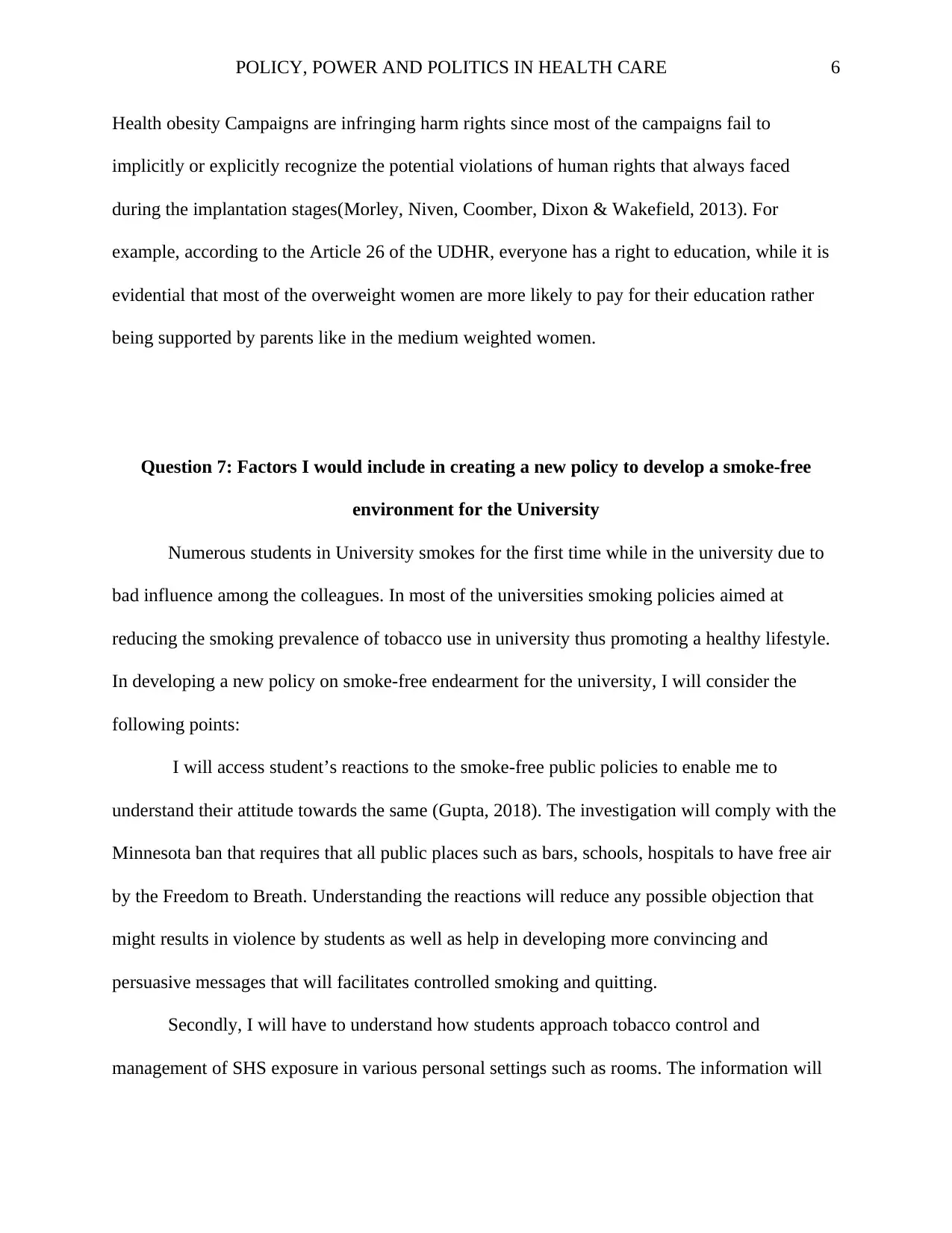
POLICY, POWER AND POLITICS IN HEALTH CARE 6
Health obesity Campaigns are infringing harm rights since most of the campaigns fail to
implicitly or explicitly recognize the potential violations of human rights that always faced
during the implantation stages(Morley, Niven, Coomber, Dixon & Wakefield, 2013). For
example, according to the Article 26 of the UDHR, everyone has a right to education, while it is
evidential that most of the overweight women are more likely to pay for their education rather
being supported by parents like in the medium weighted women.
Question 7: Factors I would include in creating a new policy to develop a smoke-free
environment for the University
Numerous students in University smokes for the first time while in the university due to
bad influence among the colleagues. In most of the universities smoking policies aimed at
reducing the smoking prevalence of tobacco use in university thus promoting a healthy lifestyle.
In developing a new policy on smoke-free endearment for the university, I will consider the
following points:
I will access student’s reactions to the smoke-free public policies to enable me to
understand their attitude towards the same (Gupta, 2018). The investigation will comply with the
Minnesota ban that requires that all public places such as bars, schools, hospitals to have free air
by the Freedom to Breath. Understanding the reactions will reduce any possible objection that
might results in violence by students as well as help in developing more convincing and
persuasive messages that will facilitates controlled smoking and quitting.
Secondly, I will have to understand how students approach tobacco control and
management of SHS exposure in various personal settings such as rooms. The information will
Health obesity Campaigns are infringing harm rights since most of the campaigns fail to
implicitly or explicitly recognize the potential violations of human rights that always faced
during the implantation stages(Morley, Niven, Coomber, Dixon & Wakefield, 2013). For
example, according to the Article 26 of the UDHR, everyone has a right to education, while it is
evidential that most of the overweight women are more likely to pay for their education rather
being supported by parents like in the medium weighted women.
Question 7: Factors I would include in creating a new policy to develop a smoke-free
environment for the University
Numerous students in University smokes for the first time while in the university due to
bad influence among the colleagues. In most of the universities smoking policies aimed at
reducing the smoking prevalence of tobacco use in university thus promoting a healthy lifestyle.
In developing a new policy on smoke-free endearment for the university, I will consider the
following points:
I will access student’s reactions to the smoke-free public policies to enable me to
understand their attitude towards the same (Gupta, 2018). The investigation will comply with the
Minnesota ban that requires that all public places such as bars, schools, hospitals to have free air
by the Freedom to Breath. Understanding the reactions will reduce any possible objection that
might results in violence by students as well as help in developing more convincing and
persuasive messages that will facilitates controlled smoking and quitting.
Secondly, I will have to understand how students approach tobacco control and
management of SHS exposure in various personal settings such as rooms. The information will
⊘ This is a preview!⊘
Do you want full access?
Subscribe today to unlock all pages.

Trusted by 1+ million students worldwide
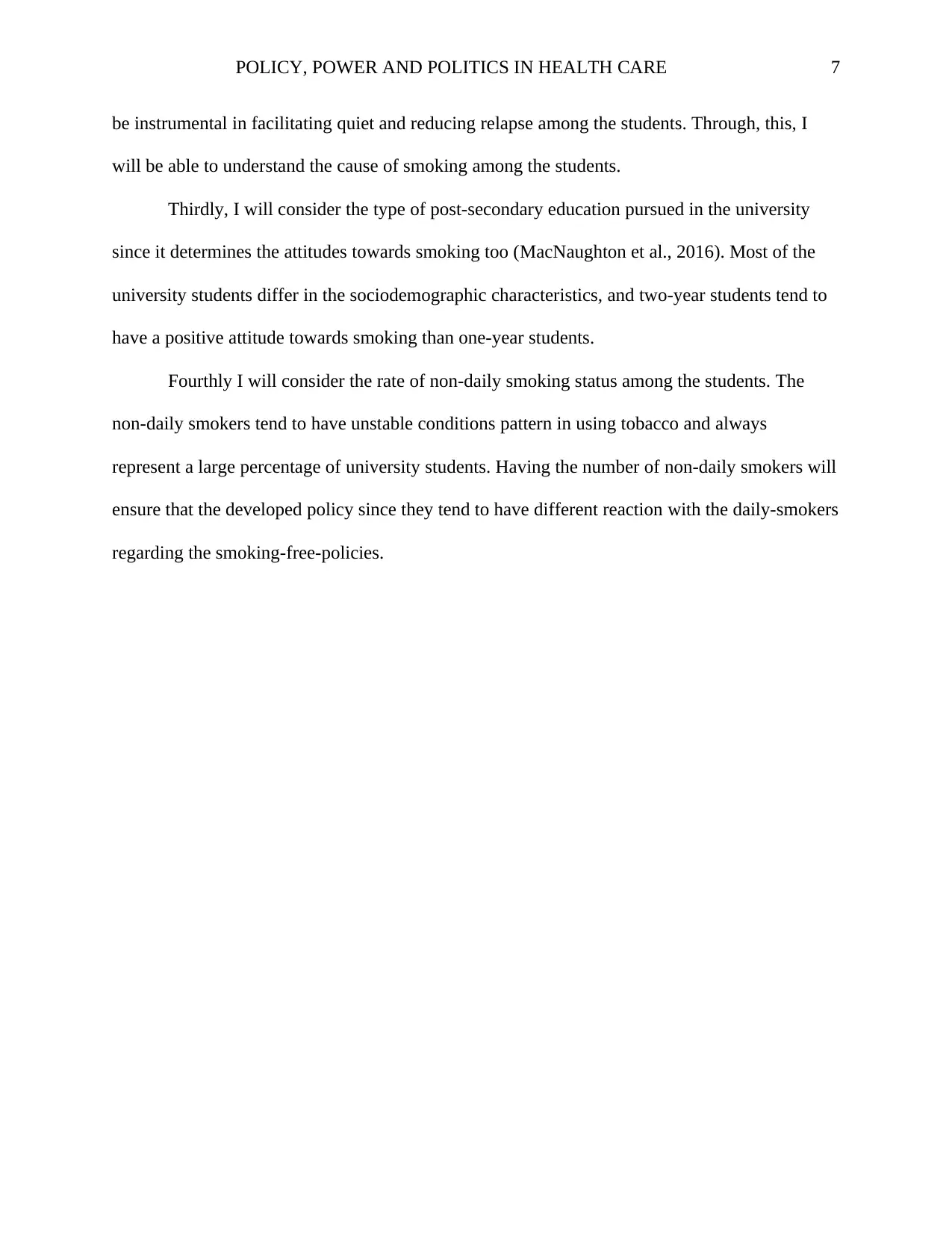
POLICY, POWER AND POLITICS IN HEALTH CARE 7
be instrumental in facilitating quiet and reducing relapse among the students. Through, this, I
will be able to understand the cause of smoking among the students.
Thirdly, I will consider the type of post-secondary education pursued in the university
since it determines the attitudes towards smoking too (MacNaughton et al., 2016). Most of the
university students differ in the sociodemographic characteristics, and two-year students tend to
have a positive attitude towards smoking than one-year students.
Fourthly I will consider the rate of non-daily smoking status among the students. The
non-daily smokers tend to have unstable conditions pattern in using tobacco and always
represent a large percentage of university students. Having the number of non-daily smokers will
ensure that the developed policy since they tend to have different reaction with the daily-smokers
regarding the smoking-free-policies.
be instrumental in facilitating quiet and reducing relapse among the students. Through, this, I
will be able to understand the cause of smoking among the students.
Thirdly, I will consider the type of post-secondary education pursued in the university
since it determines the attitudes towards smoking too (MacNaughton et al., 2016). Most of the
university students differ in the sociodemographic characteristics, and two-year students tend to
have a positive attitude towards smoking than one-year students.
Fourthly I will consider the rate of non-daily smoking status among the students. The
non-daily smokers tend to have unstable conditions pattern in using tobacco and always
represent a large percentage of university students. Having the number of non-daily smokers will
ensure that the developed policy since they tend to have different reaction with the daily-smokers
regarding the smoking-free-policies.
Paraphrase This Document
Need a fresh take? Get an instant paraphrase of this document with our AI Paraphraser
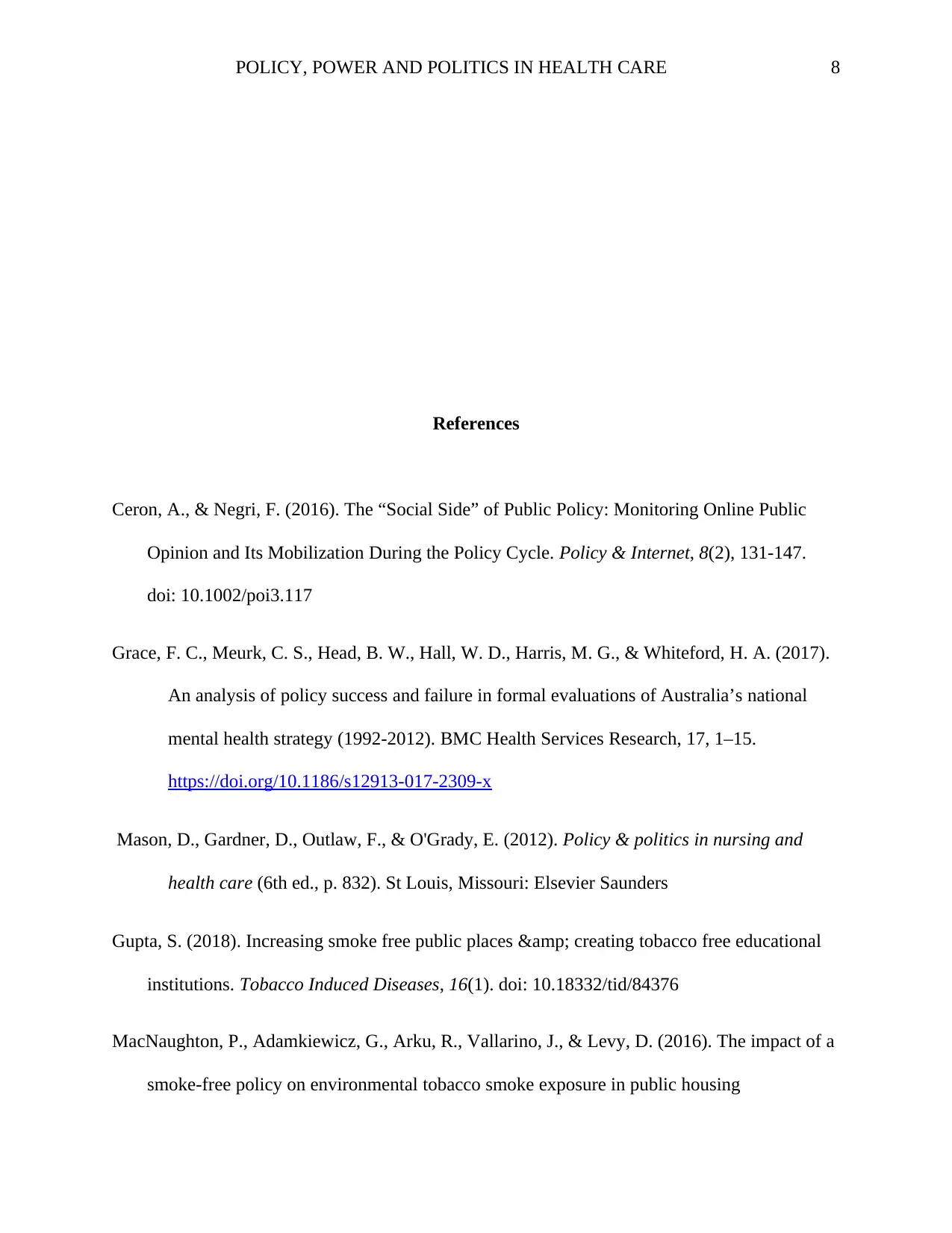
POLICY, POWER AND POLITICS IN HEALTH CARE 8
References
Ceron, A., & Negri, F. (2016). The “Social Side” of Public Policy: Monitoring Online Public
Opinion and Its Mobilization During the Policy Cycle. Policy & Internet, 8(2), 131-147.
doi: 10.1002/poi3.117
Grace, F. C., Meurk, C. S., Head, B. W., Hall, W. D., Harris, M. G., & Whiteford, H. A. (2017).
An analysis of policy success and failure in formal evaluations of Australia’s national
mental health strategy (1992-2012). BMC Health Services Research, 17, 1–15.
https://doi.org/10.1186/s12913-017-2309-x
Mason, D., Gardner, D., Outlaw, F., & O'Grady, E. (2012). Policy & politics in nursing and
health care (6th ed., p. 832). St Louis, Missouri: Elsevier Saunders
Gupta, S. (2018). Increasing smoke free public places & creating tobacco free educational
institutions. Tobacco Induced Diseases, 16(1). doi: 10.18332/tid/84376
MacNaughton, P., Adamkiewicz, G., Arku, R., Vallarino, J., & Levy, D. (2016). The impact of a
smoke-free policy on environmental tobacco smoke exposure in public housing
References
Ceron, A., & Negri, F. (2016). The “Social Side” of Public Policy: Monitoring Online Public
Opinion and Its Mobilization During the Policy Cycle. Policy & Internet, 8(2), 131-147.
doi: 10.1002/poi3.117
Grace, F. C., Meurk, C. S., Head, B. W., Hall, W. D., Harris, M. G., & Whiteford, H. A. (2017).
An analysis of policy success and failure in formal evaluations of Australia’s national
mental health strategy (1992-2012). BMC Health Services Research, 17, 1–15.
https://doi.org/10.1186/s12913-017-2309-x
Mason, D., Gardner, D., Outlaw, F., & O'Grady, E. (2012). Policy & politics in nursing and
health care (6th ed., p. 832). St Louis, Missouri: Elsevier Saunders
Gupta, S. (2018). Increasing smoke free public places & creating tobacco free educational
institutions. Tobacco Induced Diseases, 16(1). doi: 10.18332/tid/84376
MacNaughton, P., Adamkiewicz, G., Arku, R., Vallarino, J., & Levy, D. (2016). The impact of a
smoke-free policy on environmental tobacco smoke exposure in public housing
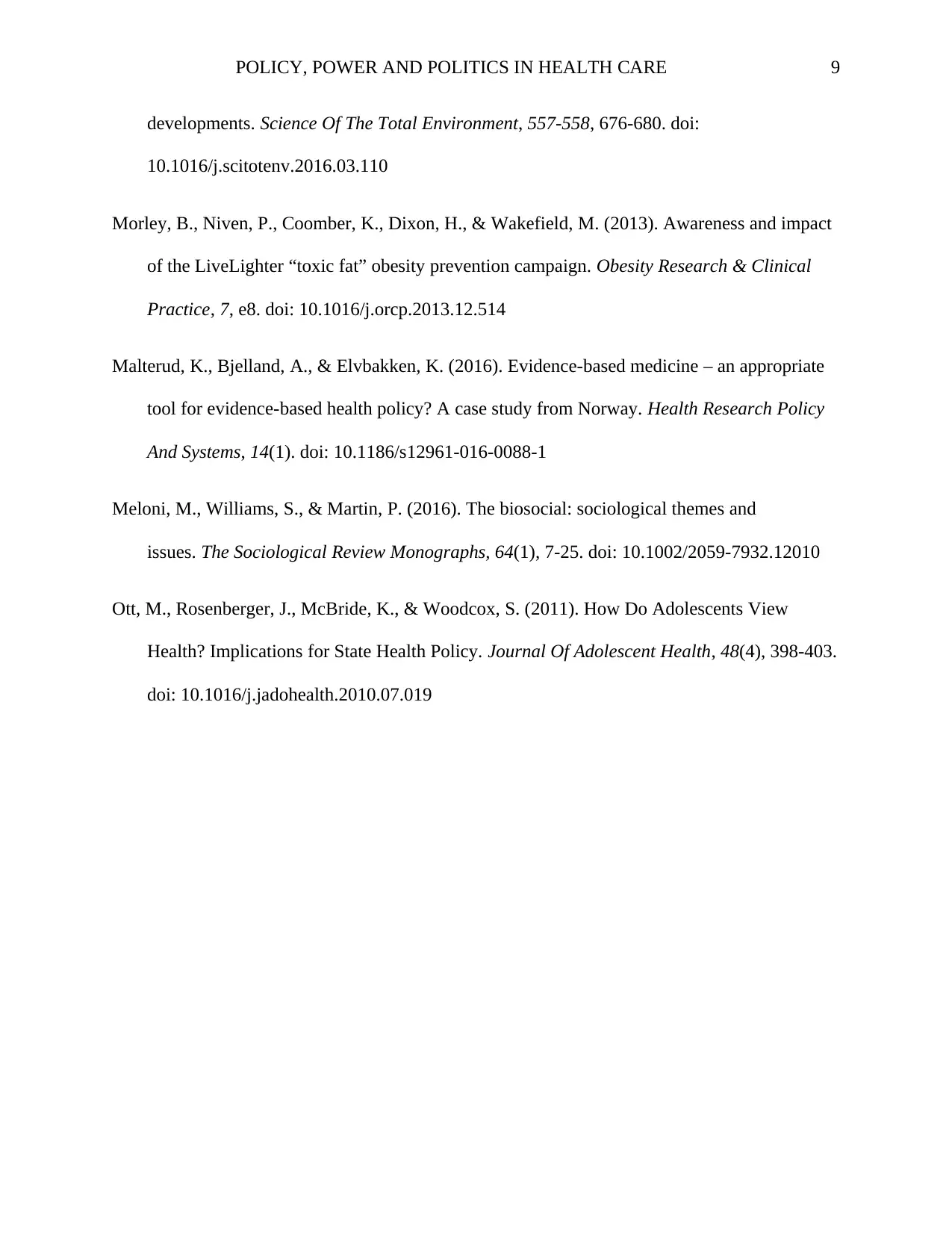
POLICY, POWER AND POLITICS IN HEALTH CARE 9
developments. Science Of The Total Environment, 557-558, 676-680. doi:
10.1016/j.scitotenv.2016.03.110
Morley, B., Niven, P., Coomber, K., Dixon, H., & Wakefield, M. (2013). Awareness and impact
of the LiveLighter “toxic fat” obesity prevention campaign. Obesity Research & Clinical
Practice, 7, e8. doi: 10.1016/j.orcp.2013.12.514
Malterud, K., Bjelland, A., & Elvbakken, K. (2016). Evidence-based medicine – an appropriate
tool for evidence-based health policy? A case study from Norway. Health Research Policy
And Systems, 14(1). doi: 10.1186/s12961-016-0088-1
Meloni, M., Williams, S., & Martin, P. (2016). The biosocial: sociological themes and
issues. The Sociological Review Monographs, 64(1), 7-25. doi: 10.1002/2059-7932.12010
Ott, M., Rosenberger, J., McBride, K., & Woodcox, S. (2011). How Do Adolescents View
Health? Implications for State Health Policy. Journal Of Adolescent Health, 48(4), 398-403.
doi: 10.1016/j.jadohealth.2010.07.019
developments. Science Of The Total Environment, 557-558, 676-680. doi:
10.1016/j.scitotenv.2016.03.110
Morley, B., Niven, P., Coomber, K., Dixon, H., & Wakefield, M. (2013). Awareness and impact
of the LiveLighter “toxic fat” obesity prevention campaign. Obesity Research & Clinical
Practice, 7, e8. doi: 10.1016/j.orcp.2013.12.514
Malterud, K., Bjelland, A., & Elvbakken, K. (2016). Evidence-based medicine – an appropriate
tool for evidence-based health policy? A case study from Norway. Health Research Policy
And Systems, 14(1). doi: 10.1186/s12961-016-0088-1
Meloni, M., Williams, S., & Martin, P. (2016). The biosocial: sociological themes and
issues. The Sociological Review Monographs, 64(1), 7-25. doi: 10.1002/2059-7932.12010
Ott, M., Rosenberger, J., McBride, K., & Woodcox, S. (2011). How Do Adolescents View
Health? Implications for State Health Policy. Journal Of Adolescent Health, 48(4), 398-403.
doi: 10.1016/j.jadohealth.2010.07.019
⊘ This is a preview!⊘
Do you want full access?
Subscribe today to unlock all pages.

Trusted by 1+ million students worldwide
1 out of 9
Related Documents
Your All-in-One AI-Powered Toolkit for Academic Success.
+13062052269
info@desklib.com
Available 24*7 on WhatsApp / Email
![[object Object]](/_next/static/media/star-bottom.7253800d.svg)
Unlock your academic potential
Copyright © 2020–2025 A2Z Services. All Rights Reserved. Developed and managed by ZUCOL.




